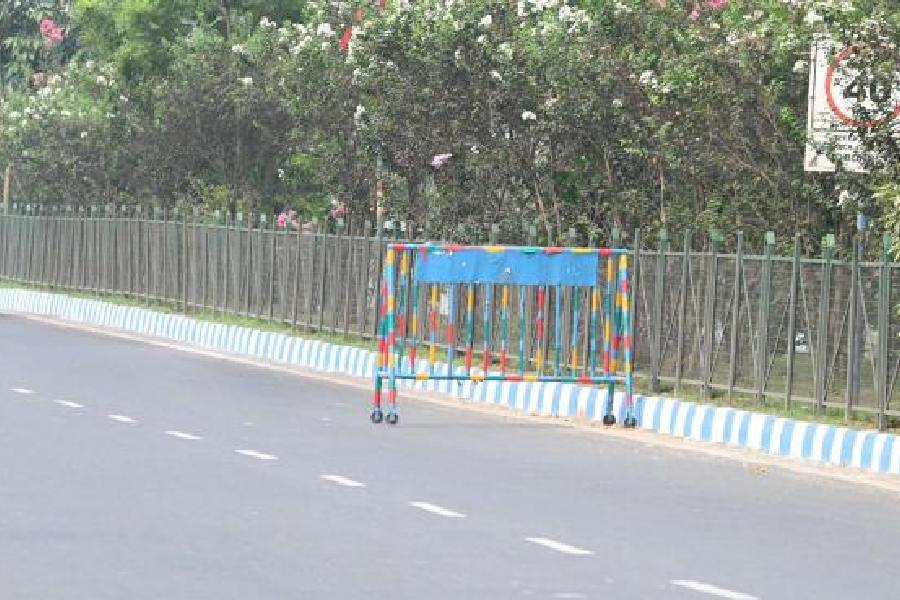Motorists plying on a long stretch of EM Bypass during the daytime are facing obstacles in the form of iron guardrails set up by the police in the middle of the thoroughfare.
Many motorists told The Telegraph that a series guardrails placed on both flanks of the 4km-stretch of the Bypass between the Ruby General Hospital intersection and the Peerless Hospital crossing were forcing them to slow down during the daytime.
Such guardrails are usually set up at night by police to check vehicles and prevent rash driving.
Senior officers of the Kolkata traffic police expressed surprise over the use of guardrails as speed breakers even during the daytime.
A senior officer at the city police headquarters in Lalbazar said he was unaware why guardrails are being placed on the Bypass during the daytime. “Usually, they (guardrails) are used as speed breakers at night. I am not aware about this particular stretch,” the officer said.
Another officer of the traffic police, who is attached to the unit that looks after the 4km stretch of the Bypass, said he would revert with the reason why the guardrails have been placed in the middle of the road during the daytime.
“The guardrails should not have been there during the daytime at all. We install guardrails only at night and they are to be removed early in the morning. On Sundays, guardrails remain on the road during the daytime, too, because traffic is usually thin and vehicles tend to speed,” the officer later said.
The Telegraph found that the use of guardrails on the EM Bypass as “speed breakers” during the daytime was limited to this stretch.
A road safety expert from Delhi said iron guardrails could pose a “serious traffic safety hazard” to vehicles.
A resident of Kasba who was traveling through the Patuli-bound flank around 9.15am on Tuesday faced a “near-crash” situation on the stretch.
“A bus was trailing our vehicle in the lane beside ours. We were heading towards Garia. Suddenly, my friend who was at the wheel spotted the guardrail in the middle of the road and tried to steer left to avoid hitting it, but a loud horn from the bus behind forced us to remain in the same lane,” he said.
The man at the wheel had no option but to press the brakes hard to prevent a collision with the guardrail. “As the guardrail forced us to stop, another car that was just behind us slammed the brakes, too. There could have been a pile-up,” the Kasba resident said.
He said he has been seeing the guardrails for more than a week. “I initially thought the police had put them up to stop and check vehicles. But no cop could be found near any of the guardrails,” he said.
The road safety expert from Delhi said it was “unscientific” to use a guardrail as a speed breaker, during the daytime or at night.
“This (use of guardrails as speed breakers) is a wrong practice. It only increases the chances of accidents. Guardrails can be used only if the police are conducting a check and need to stop a car. But if they want to reduce the speed of the cars on a certain stretch... they should use rumble strips or spring posts, which are not dangerous,” said Kamal Soi, a member of the National Road Safety Council.
Soi cited a directive of the Indian Road Congress that makes it is mandatory for the authorities to warn drivers about the presence of a speed breaker at least 100m ahead of it on either side.
“Drivers must be told in advance about the presence of a speed breaker so that they are mentally prepared and slow down in time, instead of suddenly slamming the brakes,” he said.
Many motorists this newspaper spoke to said regular prosecution based on speed camera surveillance could be more effective in checking rash driving than putting up guardrails in the middle of the road.
A motorist who frequently travels through the stretch said: “I fail to understand how guardrails can check speeding. They can only reduce the speed of the vehicles that directly face them.”
The resident of Baishnabghata Patuli, who said he had trouble negotiating the guardrails on the stretch on Tuesday morning, said: “Ideally, a speed breaker should reduce the speed of all vehicles at a particular point. But in this case, only the cars that are in the line of a guardrail slow down. The vehicles beside those cars can continue moving at the same speed.”
